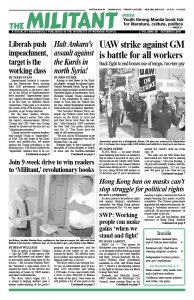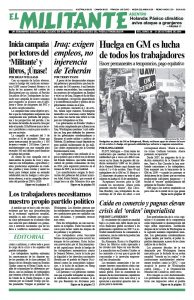As mass protests for political rights and against Beijing’s interference continued, the Hong Kong government announced Oct. 4 it was implementing a highly controversial ban on people wearing face masks at public assemblies. The Chinese government applauded the repressive measure, declaring it “extremely necessary,” and called for “all necessary measures” to restore order in the city.
Carrie Lam, the pro-Beijing chief executive of Hong Kong, invoked British colonial-era emergency powers to impose the ban. Thousands of protesters, including office workers and center city residents, immediately took to the streets to denounce this expansion of the cops’ powers.
Three days before, the Chinese rulers held a huge military parade in Beijing to showcase their emergence as a growing capitalist competitor against U.S. dominance. In his address marking the 70th anniversary of the founding of the People’s Republic, Chinese President Xi Jinping asserted, “There is no force that can shake the foundation of this great nation.”
Despite a police lockdown of Hong Kong that day, tens of thousands protested, continuing their challenge to the Chinese rulers’ authority.
Xi called for stability in Hong Kong, unity among different ethnic groups in China — a cover for the regime’s brutal suppression of the Uighurs — and the “complete unification” of the country. This is a reference to incorporating Hong Kong and Macau, the special administrative regions of China now run under the “one country, two systems” arrangement, as well as to Taiwan, a self-governing island for the past seven decades, claimed by Beijing.
Xi’s goal to impose direct rule by the central government throughout greater China is threatened by the developments in Hong Kong.
For weeks, Hong Kong police have been escalating their violent attacks in pitched battles with mostly youthful demonstrators. On Oct. 1, live ammunition was used for the first time against the protests. An 18-year-old student was shot in the chest and seriously wounded. Rubber bullets and tear gas canisters were fired, while 269 protesters were arrested as police tried to disperse thousands of demonstrators.
Some of the protesters have employed provocative tactics that have given the authorities a handle for their attacks.
Broad opposition to the ban
The Civil Human Rights Front, an umbrella organization of some 50 political, labor, professional and religious groups, has mobilized protests of between 1 and 2 million people several times since June. The group issued a statement rejecting the ban on wearing masks that was established on the basis of “severe colonial law” imposed by the British rulers in 1922.
The anti-labor law was last used in 1967 by British authorities to put down pro-Beijing “riots” supporting the so-called Cultural Revolution, a violent bureaucratic upheaval in China.
The Civil Human Rights Front noted the main reason for demonstrators “wearing masks and industrial respirators is for protection from tear gas.” Surgical masks have commonly been worn in Hong Kong since the deadly outbreak of the SARS virus there in 2002-03, as well as for protection against pollution. The organization’s statement said the masks were “also a political gesture.” The authorities use high-tech surveillance to identify and target protesters, using techniques employed at home by Beijing.
The protests began in opposition to Lam’s efforts to adopt a hated extradition bill, which would have allowed Beijing to demand the deportation of “suspects” to the mainland for trial. But after Lam was forced to drop the bill, protests continued, demanding direct election of the city administration by universal suffrage; a probe into cop violence; and an amnesty for arrested demonstrators now numbering over 2,000. They are also fighting to defend freedom of speech and assembly.

